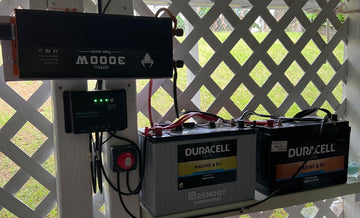Did you know? While we are enjoying the convenience and environmental benefits of solar energy, we also have to face up to a potential threat - Electro Magnetic Pulse (EMP).EMP is not only capable of causing serious interference and damage to modern electronic devices, but may even be fatal to the energy systems that rely on them, such as solar energy systems. Therefore, it is particularly important to explore in depth whether EMP can destroy solar panels and what measures we should take to prevent this disastrous consequence. In this paper, we will focus on the potential impact of EMP on solar panels and their systems from the working principle of EMP and its impact on electronic devices, and propose corresponding protection strategies.
What is EMP
EMP, or Electromagnetic Pulse, works mainly based on the basic principle of electromagnetism, that is, electric current can generate a magnetic field, and the ever-changing magnetic field can generate electric current. Specifically, the generation and working process of EMP can be summarised in the following aspects:
Generation of EMP
- Energy source: EMP can be generated by a variety of energy sources, including lightning and solar storms in nature, as well as man-made nuclear explosions and high-power microwave weapons. These energy sources are capable of releasing enormous amounts of energy in a very short period of time.
- Electromagnetic field formation: When an energy source releases energy, it creates a strong electromagnetic field in the space around it. This electromagnetic field is bursty, broadband and high-intensity, and can cover a wide area.
- Pulse Characteristics: EMP usually has a very short duration, the longest usually only lasts for about a second, but its intensity is very high and can cause serious interference or damage to electronic equipment in a very short period of time.
The working process of EMP
- Electromagnetic field propagation: The electromagnetic field generated by an EMP will propagate at the speed of light in all directions, covering a wide area. This electromagnetic field is able to penetrate various mediums, including air, soil, buildings, etc.
- Coupling: When the electromagnetic field of EMP meets with electronic equipment, coupling will occur. This coupling will generate induced currents and voltages within the electronic device.
- Destructive Mechanisms: Induced currents and voltages may exceed what the electronic equipment can withstand, leading to problems such as damage to the electronic components inside the equipment, short circuits, or loss of data. This damage is particularly severe for modern equipment that is highly integrated and dependent on electronic components.
Specific effects of EMP on electronic equipment
- Interference: Electromagnetic fields from EMP can interfere with the normal operation of electronic equipment, resulting in degradation or failure of the equipment.
- Damage: In extreme cases, EMP's electromagnetic fields can destroy electronic components and circuit structures within electronic equipment, causing permanent damage.
- Data Loss: For electronic equipment that stores important data, EMP can also cause data loss or damage, which can have a serious impact on information systems.
Effects of EMP on solar panels
The effect of EMP (Electromagnetic Pulse) on solar panels is a complex and multi-dimensional issue. Firstly, it needs to be made clear that the solar panel itself consists mainly of photovoltaic cells, which work by converting light energy into electricity, a process that does not involve complex electronic components and microprocessors. Therefore, theoretically, the direct sensitivity of solar panels to EMP is relatively low.
However, in practice, solar panels are usually connected to electronic components such as inverters, controllers, and batteries, which are more sensitive to EMP. When EMP occurs, it may affect solar panels and their systems in the following ways:
- Indirect effects: EMP may indirectly affect the performance of solar panels by affecting electronic components such as inverters and controllers. These electronic components play a vital role in the solar system, as they are responsible for converting the DC power generated by the solar panels into AC power, and for managing and distributing the power. If these components are interfered with or damaged by EMP, it will lead to abnormal operation or failure of the whole solar system.
- Electromagnetic Field Interference: Strong electromagnetic fields generated by EMP may interfere with the normal operation of solar panels and their surrounding electronic equipment. Although the solar panel itself is more resistant to EMP directly, if the electromagnetic field strength is large enough, it may still have some impact on the performance of the solar panel.
- System Stability: In a solar system, components need to collaborate with each other to ensure stable operation of the system. the occurrence of EMP may disrupt the communication and coordination mechanisms between system components, leading to a decrease in the stability of the system.
Can solar panels withstand EMP?
In general, solar panel designs have not been specifically formulated for EMP and therefore have limited resistance to EMP. While some high-end designs may offer additional protection, most common solar panels are still at risk of being damaged in a strong EMP event.
How to protect solar panels from EMP damage
Protecting solar panels from EMP (Electro Magnetic Pulse) damage is an important issue, especially considering that EMP can have a serious impact on solar panels and their connected electrical systems. The following are some effective protection measures:
1. Enhanced electromagnetic shielding
- Installation of electromagnetic shielding layers: Effective electromagnetic shielding layers are installed on solar panels and their surrounding critical electrical components (e.g. inverters, controllers, etc.). These shields can be made of conductive materials that can absorb, reflect or channel the electromagnetic energy generated by the EMP, thus reducing the impact on the solar panel and its system.
- Rational layout: During the design and installation of the solar energy system, the individual components are rationally laid out to reduce the electromagnetic field coupling effects that may be generated by the EMP.
2. Optimise electrical system design
- Use of EMP-proof electronic components: Use electronic components and inverters with EMP-proof features in solar systems. These components typically have higher electromagnetic compatibility (EMC) and electromagnetic interference (EMI) suppression capabilities, and are able to maintain normal operation in EMP environments.
- Strengthen the grounding system: Ensure that the solar system is well grounded so that electromagnetic energy generated by EMP can be quickly directed to the ground, reducing the impact on the system's internal components.
- Increase protection circuits: Add protection circuits, such as surge protectors (SPD) and over-voltage protectors, to critical parts of the solar system to cope with the transient over-voltage and over-current that may be caused by EMP.
3. Regular Inspection and Maintenance
- Regular Inspection: Regularly inspect the solar panel and its electrical system to ensure that all components are in good condition and free from looseness, corrosion or damage. Pay special attention to check whether the connecting and grounding wires are intact to prevent electromagnetic interference caused by poor contact or broken circuit.
- Maintaining cleanliness: Keep the solar panel clean and regularly remove dust, dirt and shading from the surface. This not only improves the power generation efficiency of the solar panel, but also reduces local overheating and electromagnetic field concentration caused by dust and shading.
Preventive Measures and Mitigation
- Faraday Cages: One of the most common ways to protect electronic equipment from EMP is to use Faraday cages. These are enclosures that are used to block electromagnetic fields. Placing critical components of solar systems inside these cages can protect them from potential EMP threats.
- Surge Protectors: Although primarily used for lightning protection, some surge protectors only provide limited protection against EMP-related surges.
- Redundant Systems: Having backup systems or components is invaluable, especially if the primary system is compromised.
Buy EMP (Electro Magnetic Pulse) Proof Solar Panels
There are indeed some specially designed EMP (Electro Magnetic Pulse) resistant solar panels on the market, which significantly improve the system's anti-interference performance through selected materials and unique design to ensure stable operation under strong electromagnetic environments. When choosing these special products, consumers should pay particular attention to their protection level, which is directly related to the product's ability to resist EMP impact. At the same time, it is also important to understand the product's performance guarantee measures, including the manufacturer's warranty period, maintenance services and technical support, etc., which can provide a strong guarantee for the long-term stable operation of the product. In addition, checking product certifications and third-party test reports is an effective way to assess the effectiveness of protection and help consumers make more informed purchase decisions.
FAQ
Does EMP permanently destroy electronic devices?
The extent of EMP damage depends on its strength and duration, as well as the EMP resistance of the electronic device. In extreme cases, EMP does have the potential to permanently destroy electronic equipment.
Is a metal roof EMP-proof?
Metal roofs have some electromagnetic shielding capability, but their effectiveness against EMP depends on factors such as their thickness, material and construction. In some cases, a metal roof may not be enough to completely block the effects of EMP.
What materials can block EMP?
Materials that can block EMP typically have good electrical and magnetic conductivity. For example, metals, conductive polymers, and certain composite materials can block EMP penetration to some extent. However, the exact effect will depend on the specific properties of the material and the strength of the EMP.
Are EMP-proof solar panels really effective?
The effectiveness of anti-EMP solar panels depends on whether their design and manufacturing processes have fully considered the need for EMP protection. If the product incorporates effective electromagnetic shielding technology and EMP-proof electronics, then it will be able to withstand EMP to a certain extent.
Can batteries be affected by electromagnetic pulse (EMP)?
Yes, especially battery systems with electronic controls, such as lithium batteries, can be affected by EMP, resulting in degradation or damage.













